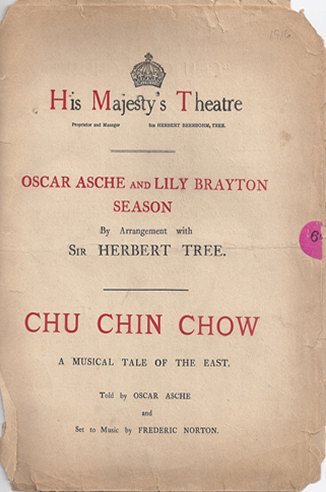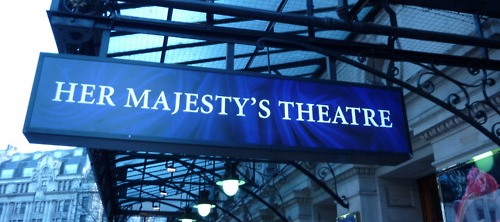
Her Majesty's Theatre
Londres - Angleterre
Construction:
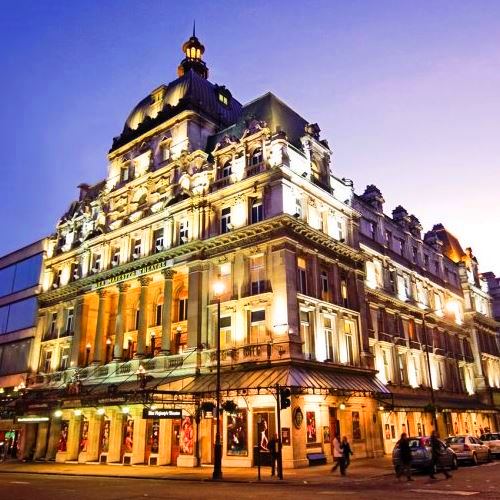
Topologie du théâtre
Nombre de salles actives: 1
Salle 1: (1100) - Actif
Accès
En métro: Piccadilly Circus
En bus: 6, 12, 13, 15, 22, 38, 58, 88
Adresse: 57 Haymarket, London, SW1Y 4QL
Evolution
Bâtiment: 1705. First theatre opens, named the Queen’s Theatre, designed by John Vanbrugh / 1791. Second theatre opens: the King’s Theatre, rebuilt by Michael Novosielski / 1869. Third theatre opens: Her Majesty’s Theatre, designed by Charles Lee / 1897. Fourth theatre opens: Her Majesty’s Theatre, designed by C. J. Phipps / Statutorily Listed Historic Building: Grade II*
Nom: Queen's Theatre / King's Theatre / Italian Opera House / His Majesty's Theatre (Le nom du théâtre change de Her Majesty's Theatre à His Majesty's Theatre si un roi monte sur le trône)
Propriétaire(s)
Really Usefull Group
Remarquable
The Royal Opera Arcade (1816) by John Nash and George Repton / Interior (1897) by Romaine Walker / Finest English wooden stage machinery in London / Beerbohm Tree founded Royal Academy of Dramatic Art on adjacent site in 1904

1100
- Actif
Today a seemingly endless stream of traffic pours down Haymarket, as it drops southwards from Piccadilly Circus to Trafalgar Square, but on 9 April 1705, when the first theatre on the site was opened, the scene was vastly different. Since the mid-17th century a hay and straw market had flourished here to such an extent that it was considered by many to be a public nuisance; but it was on Crown land, and rather than order Its closure, in 1663 King Charles II granted to the Earl of St Albans the additional right to hold a twice- weekly cattle market, probably exacerbating the existing nuisance. It was not until 1830 that the trade in hay, straw and cattle was removed to Cumberland Market to the east of Regents Park, by which time some 30,000 loads were being turned over annually.
And so it must have been a rather agricultural environment that John Vanbrugh chose in 1703 as the location for a theatre he was to design for Thomas Betterton’s company of actors, backed by ‘thirty Persons of Cuallty’, to be known as the Queen's Theatre. Vanbrugh, who was just embarking on his new career as an architect, having spent his early life soldiering, was also a playwright and an opportunist, and he decided with Betterton to take advantage of disagreement and bad management at the Theatre Royal, Drury Lane. With fellow playwright William Congreve, Vanbrugh opened with Greber's opera, The Loves of Ergasto. However, two problems rapidly became apparent: first, Vanbrugh’s grasp of financial matters was somewhat shaky; and second, his natural urge to design In the grand manner resulted, as actor and dramatist Colley Cibber famously remarked, ‘In quality and convenience being sacrificed for a vast triumphal Piece of Architecture’. Over the ensuing years debt is a recurring theme in the theatre’s history until, on 17 June 1789, the building (by now known as the King's Theatre, having been renamed on the accession of George I), was totally destroyed by fire, allegedly set by one Carnlvalll, a disgruntled former employee.
Within two years, Michael Novosielski, a trustee of the earlier theatre, reconstructed the building on a scale that made It the second largest opera house in Europe, surpassed only by La Scala, Milan. Presenting opera and ballet, It opened on 26 March 1791, again as the King’s Theatre; it was here that Mozart’s Cost fan Tutte was first produced in London (1811), followed In 1812 by The Magic Flute. To ensure that it remained fashionable, John Nash collaborated in 1816 with George Repton, son of the more famous Humphrey Repton, to remodel the building, providing the attractive Royal Opera Arcade at its western end and colonnading the remaining sides. A golden age of opera followed the reconstruction, until an apparently faithful audience drifted away to the rising Royal Opera House in Covent Garden, and the renamed Her Majesty’s Theatre (1837) was forced to close in 1852. After a period of four years the theatre reopened, only to be ravaged by fire on 6 December 1867. Again, in 1869, the theatre was rebuilt within the skeletal walls that survived the fire by Charles Lee, an architect who had worked in the office of John Nash. He provided an auditorium of a quality commensurate with the design genius of his mentor, seating up to 2,500, and with a large stage, the whole incorporating a much improved fireproof construction. However, financial problems meant that the theatre failed to open until 1875, when it was used for religious meetings; later it retúrned to staging opera, and also pantomime, until in 1890 it again closed in debt. The contents were auctioned, and the building - apart from the Royal Opera Arcade - demolished.
Over the next five years various designs were considered for building on the vacant site, and In 1895 C. J. Phipps, one of the most prolific of theatre architects, whose golden rule was 'there must not be a bad seat In the house', was commissioned to rebuild the theatre for the great actor-manager Herbert Beerbohm Tree. In the present entrance foyer Is a green marble commemoration stone laid by Maud Beerbohm Tree on 16 July 1896. The Interior decoration was to be designed by Romaine Walker, Tree’s consulting architect.
Phipps devised the present stone-faced theatre, smaller than Its predecessor, on the northern part of the site In a French Renaissance style of four main storeys under attics and a large pavilion roof, crowned by a fine square dome. The southern part of the site would be occupied by the Carlton Hotel and Restaurant, which was to be demolished In 1957 to make way for New Zealand House, a predominantly glass building by Robert Matthew, Johnson-Marshall and Partners erected in 1963 and typical of Its age. C. J. Phipps did not live to see his theatre completed, dying in 1897, but he must have known that this last work would be one of his finest achievements. Today Her Majesty’s Theatre makes an important contribution to a street of mixed architectural fortunes. From Its northern approach - Piccadilly Circus - it is sad to see the dome, designed to emphasize the presence of the building, overshadowed by the looming, now slightly dour backdrop of New Zealand House; but In the heady post-war 1950s, this unfortunate juxtaposition would have raised few eyebrows.
Internally the auditorium, with its fanned stalls seating, cantilevered balconies and gallery, has a refined French neo-classical feel. The scagliola proscenium is flanked by three-tier boxes set between Corinthian columns. The original colours of white and gold have been replaced by a warmer green and apricot with gold highlighting. The flat stage conceals the finest set of English wooden stage machinery In London, including, at fly-floor level, an unusually complete thunder run.
Beerbohm Tree, for his part, took up residence in the specially fitted-out dome, living there until his death in 1917.
Among the many notable presentations at the theatre were Oscar Asche’s Chu Chin Chow, which ran for 2,238 performances In 1916; Noël Coward's Bitter Sweet (697 performances) In 1929; Fiddler on the Roof (2,030 performances) in 1967; West Side Story in 1984; and the superb Phantom of the Opera, which opened on 9 October 1986 and is still showing in 2010.
1705. First theatre opens, named the Queen’s Theatre, designed by John Vanbrugh / 1791. Second theatre opens: the King’s Theatre, rebuilt by Michael Novosielski / 1869. Third theatre opens: Her Majesty’s Theatre, designed by Charles Lee / 1897. Fourth theatre opens: Her Majesty’s Theatre, designed by C. J. Phipps / Statutorily Listed Historic Building: Grade II*

Infos complémentaires:
The Stalls feel relatively intimate unlike other West End venues, and are only separated by an aisle running halfway down the centre. Seats grow outward from the stage but have a maximum of 35 seats per row. The circle overhang is visible from the back half of the stalls and can cover some features of the performance, most notably the infamous ‘accident’ at the end of Act One. Best seats are either side of the aisle halfway back in the stalls.
Pillars create obstructed seats at the back of the stalls in rows N and P, and it is worth checking before purchasing if you do not want a restricted view seat. Aim to sit in-between the pillars rather than directly behind them or around them. Seat Plan has learned that a good bargain may be had by purchasing a restricted view seat at a reduced price, as it is possible to sit so it is not a problem.
The Royal Circle has some excellent seats, most notably in the first six rows, nearest the centre. Because of the curve seats towards the ends of rows do become restricted, and this is reflected in the pricing structure. The section is split into three, with the central one offering the best overall view of the stage. Towards the back of each section however the overhang and pillars can create problems, and it is best to check before you book if this will be a problem. Pillars feature in row E, once in each side section and twice in the middle.
The Grand Circle is again split into three sections with a large block shaped central section. All seats in the central area are priced the same, and are heavily raked for a fuller view of the stage. Seat Plan has had some trouble with leg room in this section however, as well as with tourists who wish to talk throughout the show... Slightly cheaper in price, seats to the left and right of the Grand Circle, (especially those towards the front) boast great views of the stage. Unlike other theatres the balcony does not overhang the Grand Circle, so does not create any problems obstructing the view.
The Balcony in Her Majesty’s is not for the faint hearted. Set back from the Upper Circle rather than overhanging it, seats are raked and look sharply down onto the action. These seats are suitable for those wishing to see the show for cheap, but do not have a good sound or visual quality. Leg room is limited, and it can get hot during the summer. Seat Plan recommends paying that bit extra for the Upper Circle for a better experience, as it feels easily detached from the action. One redeeming feature however is the view of the Chandelier, and the ability to spot the Phantom in his movements around the auditorium.
Queen's Theatre / King's Theatre / Italian Opera House / His Majesty's Theatre (Le nom du théâtre change de Her Majesty's Theatre à His Majesty's Theatre si un roi monte sur le trône)
The Royal Opera Arcade (1816) by John Nash and George Repton / Interior (1897) by Romaine Walker / Finest English wooden stage machinery in London / Beerbohm Tree founded Royal Academy of Dramatic Art on adjacent site in 1904

Musical
Original
1) Phantom of the Opera (The) (Original)
Joué durant 33 ans 6 mois actuellement
Première preview: sam. 27 septembre 1986
Première: jeu. 09 octobre 1986
Dernière: Open end
Compositeur: Andrew Lloyd Webber •
Parolier: Charles Hart • Richard Stilgoe •
Libettiste:
Metteur en scène: Harold Prince •
Chorégraphe: Gillian Lynne •
Avec: Michael Crawford (Phantom), Sarah Brightman/Claire Moore (Christine), Steve Barton (Raoul), David Firth (Monsieur André), John Savident (Monsieur Firmin), Rosemary Ashe (Carlotta), Mary Millar (Madame Giry)
Commentaire: Based on the 1910 novel “Le Fantome de l’Opera” ” by Gaston Leroux, “Phantom” began previews on September 27, 1986 and opened on October 9th. The production, still playing at Her Majesty's, celebrated its 24th anniversary in October 2010 and its 10,000th performance at the matinee on 23rd October 2010. It is the second longest-running West End musical in history behind Les Miserables.
“Phantom” won the 1986 Olivier and the 1988 Tony Award for Best Musical, and Michael Crawford won the Best Performer Award at both ceremonies. The show has been seen in 149 cities in 25 countries, and has played to over 100 million people. With total worldwide box office sales of over £3.5 billion it is the highest-grossing entertainment event of all time. The New York production alone has grossed US $800 million, making it the most financially successful Broadway show in history.
During its 25 years (and still running) in London, notable replacements in the role of Phantom have been Dave Willetts, Martin Smith, Peter Karrie, Peter Polycarpou, Simon Bowman, Peter Cousens, Mike Sterling, John Owen-Jones, Ramin Karimloo, and Nic Greenshields.
Replacement Christines have included Claire Moore, Rebecca Caine, Myra Malmberg, Rachel Barrell, Leila Benn Haerris, Robyn North and Gina Beck.
Replacement Raouls have included Michael Ball, Robert Meadmore, John Barrowman, Simon Burke, Clive Carter, Simon Bowman, Ramin Karimloo and Oliver Thornton. (plus)
Presse:
Plus d'infos sur cette production:
Plus d'infos sur ce musical

Musical
Original
30) Fermeture COVID (Original)
Joué durant 1 an 4 mois
Première preview: 16 March 2020
Première: 16 March 2020
Dernière: 19 July 2021
Compositeur:
Parolier:
Libettiste:
Metteur en scène:
Chorégraphe:
Avec:
Commentaire: Tous les théâtres anglais ont dû fermer dès le 16 mars 2020 suite à la pandémide de COVID… (plus)
Presse:
Plus d'infos sur cette production:
Plus d'infos sur ce musical

Musical
Revival
29) West Side Story (Revival)
Joué durant 1 an 4 mois 2 semaines
Première preview: 16 May 1984
Première: 16 May 1984
Dernière: 28 September 1985
Compositeur: Leonard Bernstein •
Parolier: Stephen Sondheim •
Libettiste: Arthur Laurents •
Metteur en scène: Jerome Robbins • Tom Abbott •
Chorégraphe: Jerome Robbins • Tom Abbott •
Avec: Steven Pacey (Tony), Jan Hartley (Maria), Richard Pettyfer (Riff), Sam Williams (Bernardo), Lee Robinson (Anita), David Morris (ii) (Chino), Adam Matalon (Action), Peter Leeper (A-Rab), Ian Embleton (Baby John), Garry Noakes (Snowboy)
Commentaire: This production had originated at Leicester Haymarket and opened in December 1983. It had been on a UK tour which culminated in a West End season from May 1984 to October 1985. Later cast changes saw Peter Bruce and Karyn O’Neill take over the leads. (plus)
Presse:
Plus d'infos sur cette production:
Plus d'infos sur ce musical
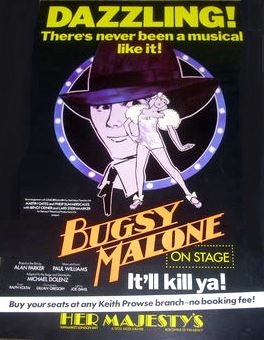
Musical
Original
28) Bugsy Malone (Original)
Joué durant 8 mois 3 semaines
Nb de représentations: 300 représentations
Première preview: Inconnu
Première: 26 May 1983
Dernière: 11 February 1984
Compositeur: Paul Williams •
Parolier: Paul Williams •
Libettiste: Mickey Dolenz •
Metteur en scène: Mickey Dolenz •
Chorégraphe: Gillian Gregory •
Avec:
Commentaire: Notes: This theatrical curiosity used an all-child cast to re-create the Alan Parker film, but instead of machine gun killings, the young people spray each other with splurge guns. The children handle the dialogue themselves, but then mime the songs to the off-stage singing of adults. The first Bugsy was played by Jeremy Gilley. The laws concerning performers under the age of 16 meant that the cast was constantly changing. While the show might possibly have had some value in youth companies and schools, the general view was that it had no business whatsoever to occupy a major West End theatre. (plus)
Presse:
Plus d'infos sur cette production:
Plus d'infos sur ce musical

Musical
Recréation
27) Streets of London (The) (Recréation)
Joué durant 3 mois 1 semaine
Nb de représentations: 122 représentations
Première preview: Inconnu
Première: 21 October 1980
Dernière: 31 January 1981
Compositeur: *** Divers •
Parolier: *** Divers •
Libettiste: *** Divers •
Metteur en scène: Diane Cilento •
Chorégraphe: Noel Tovey •
Avec: William Squire (Gideon Bloodgood), Michael Carter (Badger), Helen Cherry (Mrs Fairweather), Susannah Fellows (Lucy Fairweather), Richard Walsh (Paul Fairweather), Royce Mills (Edwards), Jane Wymark (Alida Bloodgood), Mark Livingstone (Frank Grimes), Shaun Curry
Commentaire: Dion Boucicault’s play of dastardly doings and retributions was adapted from the French “Les pauvres de Paris” and was first presented in New York in 1857 under the title “The Streets of New York”. When Boucicault returned to England it was performed as “The Streets of Liverpool” and then changed its title according to whichever town it was performed in on its way to London. The play mixed melodramatic spectacle and social observation to become a Christian sermon in which the audience was encouraged to give to the poor on their way out of the theatre. Even in its earliest form it was accompanied by music-hall type songs
This new musical version originated at the Theatre Royal, Stratford East for a three week season in March, and then was much re-written and enlarged for its West End run. In its original 1864 London production the sensation was the scene of a burning house with a real fire-engine and real horses on stage. This scene worked well on the small East London stage, but seemed rather feeble on the vast expanses of Her Majesty’s Theatre. The show was praised by the critics but failed to run very long. (plus)
Presse:
Plus d'infos sur cette production:
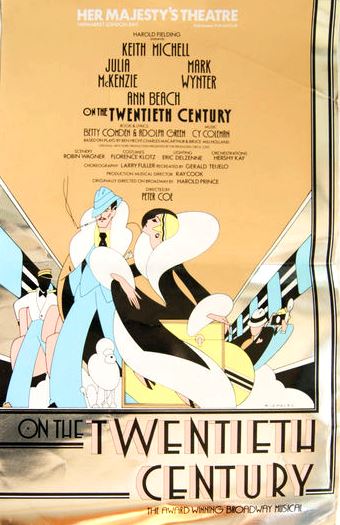
Musical
Original London
26) On the Twentieth Century (Original London)
Joué durant
Nb de représentations: 165 représentations
Première preview: Inconnu
Première: 19 March 1980
Dernière: Inconnu
Compositeur: Cy Coleman •
Parolier: Adolph Green • Betty Comden •
Libettiste: Adolph Green • Betty Comden •
Metteur en scène: Peter Coe •
Chorégraphe: Larry Fuller •
Avec: Keith Michell (Oscar Jaffee), Julia McKenzie (Lily Garland),
Mark Wynter (Bruce Granit), Ann Beach (Letitia Primrose),
Jeff Wayne, Fred Evans, David Healy, Peter Johnston
Commentaire:
Presse:
Plus d'infos sur cette production:
Plus d'infos sur ce musical

Musical
Original London
25) Ain't Misbehavin' (Original London)
Joué durant
Nb de représentations: 196 représentations
Première preview: Inconnu
Première: 22 March 1979
Dernière: Inconnu
Compositeur: *** Divers •
Parolier: *** Divers •
Libettiste: Murray Horweitz • Richard Jr Maltby •
Metteur en scène: Richard Jr Maltby •
Chorégraphe: Arthur Faria •
Avec: Evan Bell, André de Shields, Annie Joe Edwards, Jozella Reed, Charlaine Woodard
Commentaire: A musical revue and tribute to the black musicians of the 1920s and 1930s who
were part of the Harlem Renaissance, an era of growing creativity, cultural awareness, and ethnic pride. Manhattan nightclubs like the Cotton Club and the Savoy Ballroom attracted the high society, while the Lennox Avenue low-down dives were filled with piano players banging out the new beat known as swing. Five performers present an evening of rowdy, raunchy, and humorous songs that encapsulate the various moods of the era and vaguely tell the story and philosophy of Fats Waller. (plus)
Presse:
Plus d'infos sur cette production:
Plus d'infos sur ce musical

Musical
Original
24) Traveling Music Show (The) (Original)
Joué durant
Première preview: Inconnu
Première: 28 March 1978
Dernière: Inconnu
Compositeur: Anthony Newley • Leslie Bricusse •
Parolier: Anthony Newley • Leslie Bricusse •
Libettiste:
Metteur en scène: Burt Shevelove •
Chorégraphe: Norman Maen •
Avec: Bruce Forsyth (Fred Limelight), Valerie Walsh (Evie Limelight), Katie Budd (Sam Limelight), Derek Griffiths (Reg), Tony Maiden (Kim)
Commentaire: The show is a series of sketches evoking street-comer rip-off artists and tawdry tourist tat, using the hit songs Leslie Bricusse and Anthony Newley had written for their earlier shows. “The Good Old Bad Old Days” is performed by Fred and Reg as two incontinent drunks, and “Nothing Can Stop Me Now” is performed by a quivering goalkeeper. With Bruce Forsyth ad-libbing throughout in his accepted breezy manner, this was a variety show cum revue rather than any kind of structured musical. (plus)
Presse:
Plus d'infos sur cette production:
Plus d'infos sur ce musical

Musical
Revival
23) Godspell (Revival)
Joué durant
Nb de représentations: 98 représentations
Première preview: 10 May 1977
Première: 10 May 1977
Dernière: Inconnu
Compositeur: Stephen Schwartz •
Parolier: Stephen Schwartz •
Libettiste:
Metteur en scène: Robert Cheeseman •
Chorégraphe: Rowan Stuart •
Avec: Allan Love (Jesus), Susan Beagley, Paul Burton, Anna Daventry, Paul Kerryson, Edward Newborn, Valerie Minifie, Janet Shaw, Andrew Secombe.
Commentaire: This was a short “fill-in” following the collapse of “Fire Angel - it was already on a UK tour. (plus)
Presse:
Plus d'infos sur cette production:
Plus d'infos sur ce musical

Musical
Original
22) By Jeeves (Original)
Joué durant 1 mois
Nb de représentations: 38 représentations
Première preview: Inconnu
Première: 22 April 1975
Dernière: 24 May 1975
Compositeur: Andrew Lloyd Webber •
Parolier: Alan Ayckbourn •
Libettiste: Alan Ayckbourn • Andrew Lloyd Webber •
Metteur en scène: Eric Thompson •
Chorégraphe: Christopher Bruce •
Avec:
Commentaire: Le titre à l'époque était "Jeeves", tout simplement.
Terrible Flop. Le metteur en scène, Eric Thompson, est viré à quelques jours de la première. (plus)
Presse:
Plus d'infos sur cette production:
Plus d'infos sur ce musical
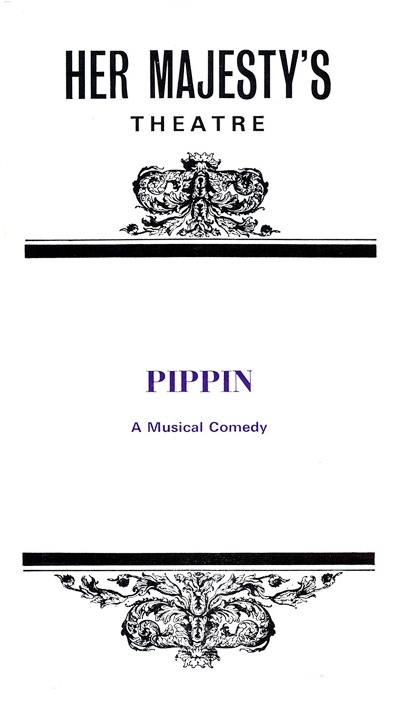
Musical
Original London
21) Pippin (Original London)
Joué durant
Nb de représentations: 85 représentations
Première preview: 30 October 1973
Première: 30 October 1973
Dernière: Inconnu
Compositeur: Stephen Schwartz •
Parolier: Stephen Schwartz •
Libettiste: Roger O. Hirson •
Metteur en scène: Bob Fosse •
Chorégraphe: Bob Fosse •
Avec: Norman J. Calloway (Leading Player) , Paul Jones (Pippin) , John Turner (Charlelemagne ), Bobby Bannerman (Lewis), Diane Langton (Fastrada), Elisabeth Welch (Berthe)
Commentaire: This was an anti-war story in a commedia-dell-arte style, reminiscent of the “flower power” philosophy of the recent past, and was a great success on Broadway, running for 1.944 performances. The London production was an expensive flop. (plus)
Presse:
Plus d'infos sur cette production:
Plus d'infos sur ce musical

Musical
Original London
20) Applause (Original London)
Joué durant
Nb de représentations: 382 représentations
Première preview: Inconnu
Première: 16 November 1972
Dernière: Inconnu
Compositeur: Charles Strouse •
Parolier: Lee Adams •
Libettiste: Adolph Green • Betty Comden •
Metteur en scène: Ron Field •
Chorégraphe: Ron Field •
Avec:
Commentaire:
Presse:
Plus d'infos sur cette production:
Plus d'infos sur ce musical

Musical
Original London
19) Company (Original London)
Joué durant 9 mois 3 semaines
Nb de représentations: 344 représentations
Première preview: 18 January 1972
Première: 18 January 1972
Dernière: 04 November 1972
Compositeur: Stephen Sondheim •
Parolier: Stephen Sondheim •
Libettiste: George Furth •
Metteur en scène: Harold Prince •
Chorégraphe: Michael Bennet •
Avec: Robert … Larry Kert
Sarah … Marti Stevens
Harry … Kenneth Kimmins
Susan … Joy Franz
Peter … J. T. Cromwell
Jenny … Teri Ralston
David … Lee Goodman
Amy … Beth Howland
Paul … Steve Elmore
Joanne … Elaine Stritch
Larry … Robert Goss
Marta … Annie McGreevey
Kathy … Donna McKechnie
April … Carol Richards
Commentaire:
Presse:
Plus d'infos sur cette production:
Plus d'infos sur ce musical

Musical
Original London
18) Fiddler on the Roof (Original London)
Joué durant
Nb de représentations: 2030 représentations
Première preview: Inconnu
Première: 16 February 1967
Dernière: Inconnu
Compositeur: Jerry Bock •
Parolier: Sheldon Harnick •
Libettiste: Joseph Stein •
Metteur en scène:
Chorégraphe:
Avec:
Commentaire:
Presse:
Plus d'infos sur cette production:
Plus d'infos sur ce musical

Musical
Original London
17) Bye Bye Birdie (Original London)
Joué durant
Nb de représentations: 268 représentations
Première preview: Inconnu
Première: 15 June 1961
Dernière: Inconnu
Compositeur: Charles Strouse •
Parolier: Lee Adams •
Libettiste: Michael Stewart •
Metteur en scène: Gower Champion •
Chorégraphe: Gower Champion •
Avec:
Commentaire:
Presse:
Plus d'infos sur cette production:
Plus d'infos sur ce musical
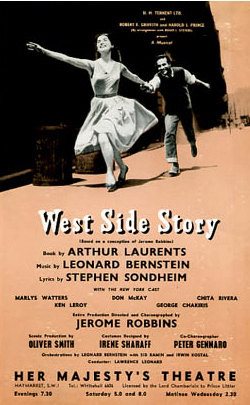
Musical
Original London
16) West Side Story (Original London)
Joué durant
Nb de représentations: 1039 représentations
Première preview: 12 December 1958
Première: 12 December 1958
Dernière: Inconnu
Compositeur: Leonard Bernstein •
Parolier: Stephen Sondheim •
Libettiste: Arthur Laurents •
Metteur en scène: Jerome Robbins •
Chorégraphe: Jerome Robbins •
Avec: George Chakiris (Riff), Don McKay (Tony), Eddie Roll (Action), Tony Mordente (A-Rab), Ed Verso (Baby John), Riggs O'Hara (Snowboy), David Bean (Big Deal), Gary Cockrell (Diesel), Michael Kleinman (Gee-Tar), Joe Donovan (Mouthpiece)
Commentaire:
Presse:
Plus d'infos sur cette production:
Plus d'infos sur ce musical
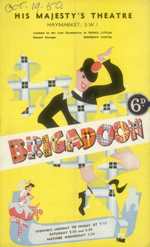
Musical
Revival
15) Brigadoon (Revival)
Joué durant
Nb de représentations: 685 représentations
Première preview: Inconnu
Première: 14 April 1949
Dernière: Inconnu
Compositeur: Frederik Loewe •
Parolier: Alan Jay Lerner •
Libettiste: Alan Jay Lerner •
Metteur en scène:
Chorégraphe:
Avec:
Commentaire:
Presse:
Plus d'infos sur cette production:
Plus d'infos sur ce musical
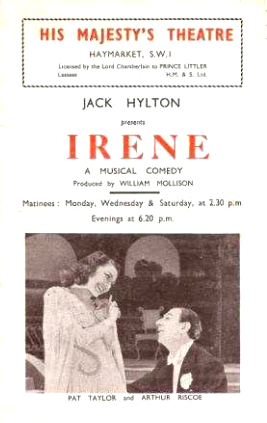
Musical
Revival
14) Irene (Revival)
Joué durant 4 mois 1 semaine
Nb de représentations: 158 représentations
Première preview: 21 March 1945
Première: 21 March 1945
Dernière: 28 July 1945
Compositeur: Harry Tierney •
Parolier: Joseph McCarthy •
Libettiste: James Montgomery •
Metteur en scène: William Mollison •
Chorégraphe: ???? ???? •
Avec: Pat Taylor (Irene Dare), Frank Leighton (Donald Marshall), Arthur Riscoe (Mme Lucy), Mignon O’Doherty (Mrs O ’Dare), Doreen Percheron (Helen)
Commentaire:
Presse:
Plus d'infos sur cette production:
Plus d'infos sur ce musical

Opérette
Revival
13) Merry Widow (The) (Revival)
Joué durant 10 mois
Nb de représentations: 302 représentations
Première preview: 04 March 1943
Première: 04 March 1943
Dernière: 1944
Compositeur: Franz Lehar •
Parolier: Christopher Hassall •
Libettiste:
Metteur en scène: William Mollison • Cyril Ritchard •
Chorégraphe:
Avec: Madge Elliott (Sonia), Cyril Ritchard (Danilo), Nancy Evans (Natalie), George Graves (Popoff) , Charles Dorning (Vicomte Camille), Grant Tickle (Marquis), Carol Raye (Frou-Frou)
Commentaire: Notes : La production a subi une certaine révision et mise à jour, et surtout le final de l’acte I avec le Maxim’s devenu une sorte de cabaret, avec une ligne de danseuses Can-Can, et avec une valse de Strauss. (plus)
Presse:
Plus d'infos sur cette production:
Plus d'infos sur ce musical

Musical
Original London
12) Du Barry Was a Lady (Original London)
Joué durant
Nb de représentations: 178 représentations
Première preview: 22 October 1942
Première: 22 October 1942
Dernière: Inconnu
Compositeur: Cole Porter •
Parolier: Cole Porter •
Libettiste: B.G. DeSylva • Herbert Fields •
Metteur en scène: Richard Bird •
Chorégraphe: Joan Davis •
Avec: Arthur Riscoe (Louis Blore), Frances Day (May Daly), Frances Marsden (Alice Barton), Jackie Hunter (Charley), Bruce Trent (Alex Barton), Teddy Beaumont (Harry Norton)
Commentaire: La production londonienne a été transférée du His Majesty's Theatre au Phoenix Theatre pour faire place à la pantomime de Jack Hylton Jack and Jill avec Arthur Askey. (plus)
Presse:
Plus d'infos sur cette production:
Plus d'infos sur ce musical

Musical
Original
11) Balalaika (Original)
Joué durant
Nb de représentations: 569 représentations
Première preview: Inconnu
Première: 22 December 1936
Dernière: Inconnu
Compositeur: Eric Maschwitz •
Parolier: Bernard Grun • George Posford •
Libettiste: Bernard Grun • George Posford •
Metteur en scène: Leontine Sagan •
Chorégraphe: Joan Davis •
Avec: Eric Marshall (Colonel Balakirev), Dorothy Seacombe (Mrs Morrison), Bennett O’Loughlan (Randall P. Morrison), Roger Treville (Peter Karagin), Muriel Angelus (Lydia Marakova), Jerrold Robertshaw (Prince Karagin), Arthur Hardy (Marakov), Clifford Mollinson (Nicki), Betty Warren (Masha)
Commentaire: This is a revised version of the 1933 play “The Great Hussar”. With gipsy songs and dances, a major ballet performance, dramatic revolution scenes, and Cossack dancing it was a great critical and popular success.
An MGM film version was made in 1939 starring Nelson Eddy and Ilona Massey using a new score made up of songs by Sigmund Romberg. Only one song, “At the Balalaika” remained from the original stage show.
London Run: Adelphi Theatre 22/12/1936 - Transferred to His Majesty's 6/2/1937 - Transferred to Adelphi 19/2/1938. (plus)
Presse:
Plus d'infos sur cette production:
Plus d'infos sur ce musical
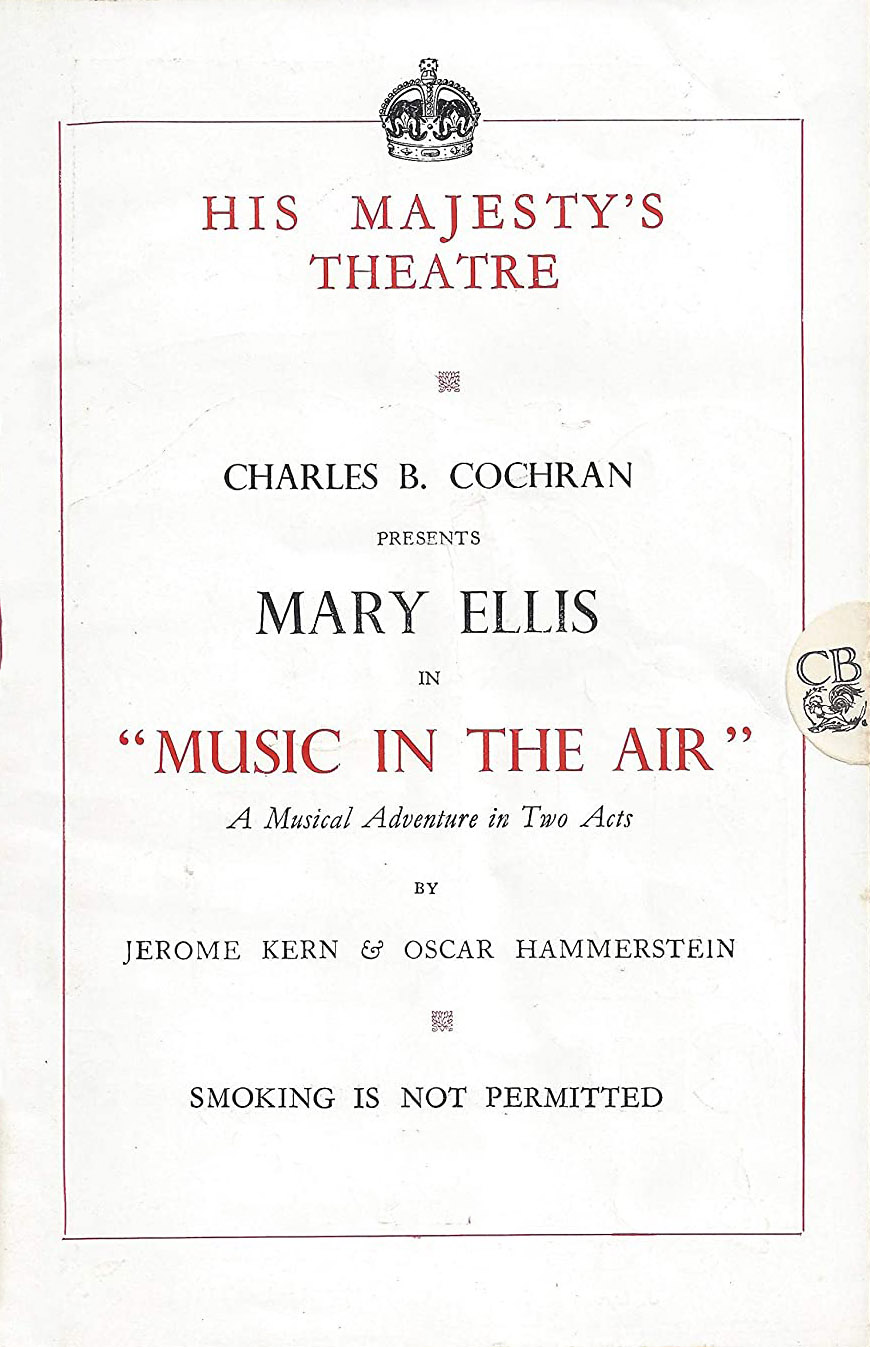
Musical
Original London
10) Music in the Air (Original London)
Joué durant 7 mois 4 semaines
Nb de représentations: 272 représentations
Première preview: 19 May 1933
Première: 19 May 1933
Dernière: 19 January 1934
Compositeur: Jerome Kern •
Parolier: Oscar Hammerstein II •
Libettiste: Oscar Hammerstein II •
Metteur en scène: Oscar Hammerstein II • Jerome Kern •
Chorégraphe:
Avec: Mary Ellis (Frieda Hatzfeld), Arthur Margetson (Bruno Mahler), Eve Lister (Sieglinde Lessing), Horace Hodges (Dr Walther Lessing), Bruce Carfax (Karl Reder), Herbert Ross (Ernst Weber), Muriel George (Lili Kirschner), Lance Fairfax (Cornelius)
Commentaire: Kern and Hammerstein re-created the show in London (plus)
Presse:
Plus d'infos sur cette production:
Plus d'infos sur ce musical

Musical
Original London
9) Die Dubarry (Original London)
Joué durant
Nb de représentations: 397 représentations
Première preview: 14 April 1932
Première: 14 April 1932
Dernière: Inconnu
Compositeur: Karl Millöcker •
Parolier: Paul Knepler •
Libettiste: Paul Knepler • Rowland Leigh •
Metteur en scène: Felix Edwardes •
Chorégraphe: Anton Dolin •
Avec: Anny Ahlers (Jeanne), Margaret Yarde (Mme. Labille), Heddle Nash (René Lavallery), Edmund Willard (Comte Dubarry), Helen Haye (Maréchale de France), Lawrence Anderson (Louis XV)
Commentaire:
Presse:
Plus d'infos sur cette production:
Plus d'infos sur ce musical
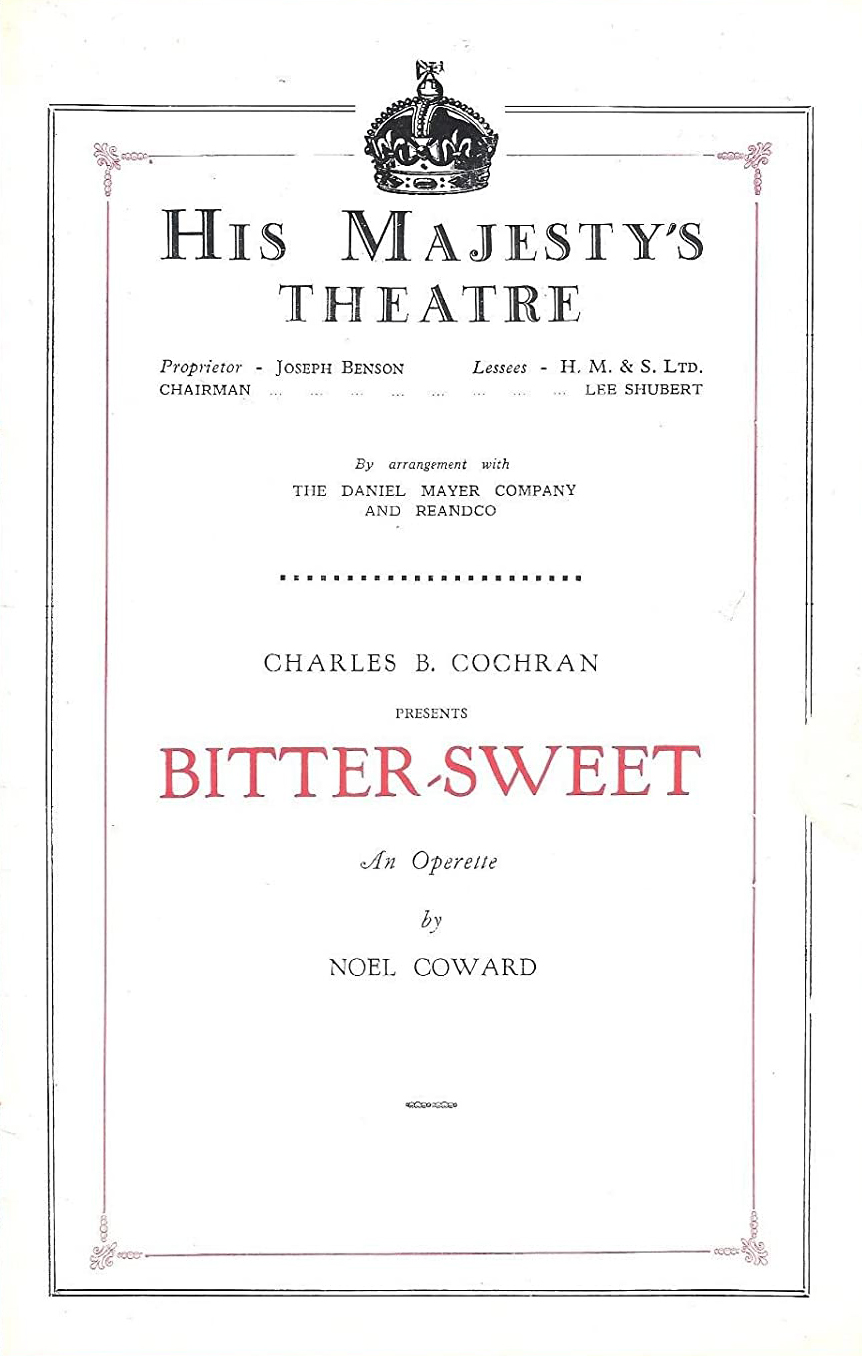
Musical
Original
8) Bitter Sweet (Original)
Joué durant 1 an 7 mois 2 semaines
Nb de représentations: 728 représentations
Première preview: Inconnu
Première: 18 July 1929
Dernière: 28 February 1931
Compositeur: Noël Coward •
Parolier: Noël Coward •
Libettiste: Noël Coward •
Metteur en scène:
Chorégraphe:
Avec: Claude Farrow, Dorothy Bond, William Harn, Billy Milton, Peggy Wood, Alan Napier, George Metaxa, Ivy St Helier, Isla Bevan, Austin Trevor, Robert Newton, Nancy Bevill, Maureen Moore, Arthur Alexander
Commentaire: Transféré au Palace Theatre du 2/3/1934 au 21/3/1931 (plus)
Presse:
Plus d'infos sur cette production:
Plus d'infos sur ce musical
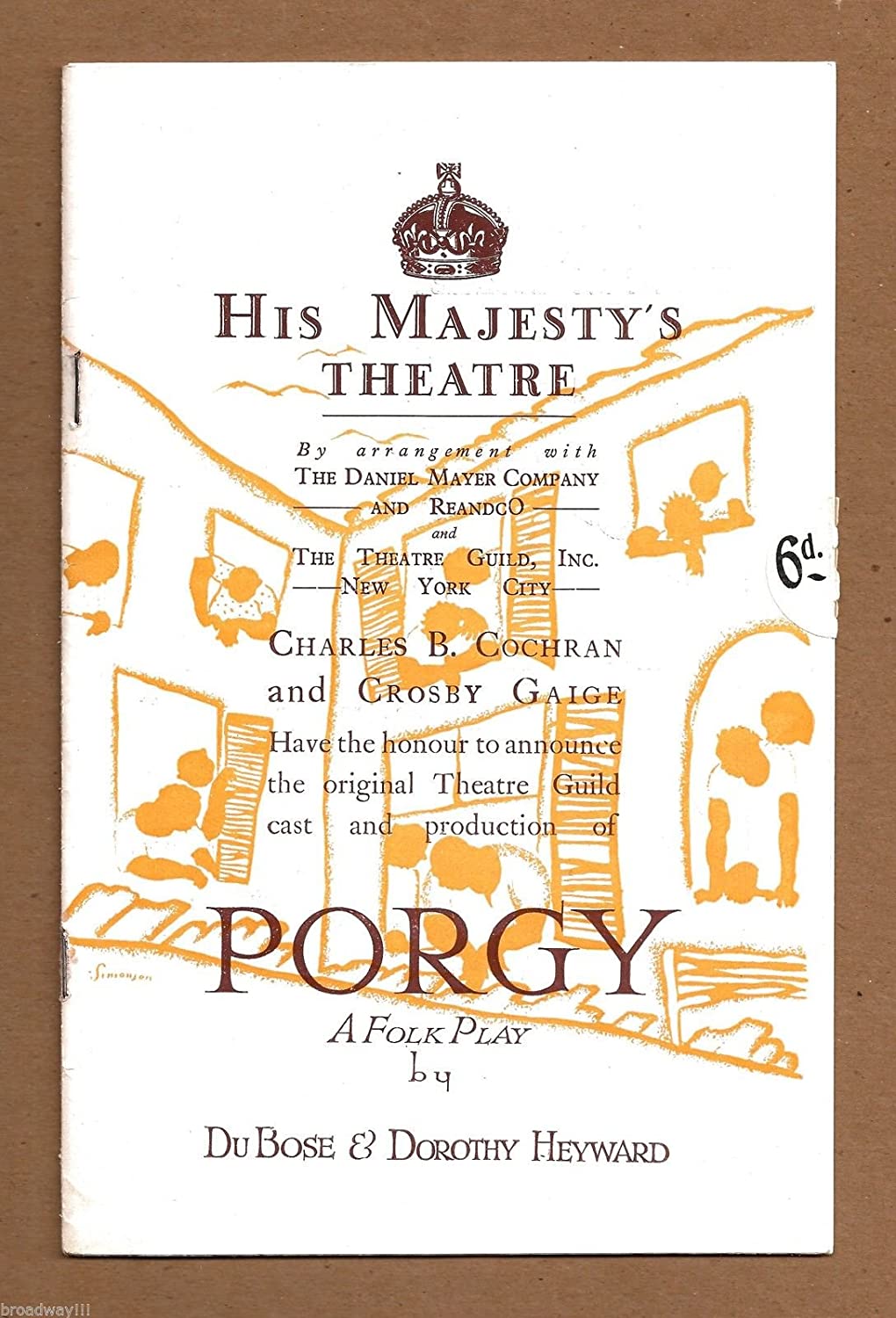
Théâtre
Original London
7) Porgy (Original London)
Joué durant 1 mois 3 semaines
Nb de représentations: 61 représentations
Première preview: 10 April 1929
Première: 10 April 1929
Dernière: 01 June 1929
Compositeur:
Parolier:
Libettiste: Dorothy Heyward • DuBose Heyward •
Metteur en scène: Rouben Mamoulian •
Chorégraphe:
Avec: Wesley Hill (Jake), Richard Huey (Mingo), Percy Verwayne (Sporting Life), Morris McKenney (Robbins), Peter Clarke (Jim), Hayes Pryor (Peter), Frank Wilson (Porgy), Jack Carter (Crown), Frederick Smith (Detective), Felix Jacoves (Policeman), Edward Hartford (Policeman), Leigh Whipper (Undertaker, Crabman), Garrett Minturn (Coroner), Wallace Hill (Scipio), A. B. Comathiere (Simon Frazier), G. Edward Brown (Nelson), Erskine Sanford (Alan Archdale), Frank Allen, Richard Bruce, Edward Chavers, John Dowling, Carl Mahon, Smith Reed, Edward Perry, Philip Thomas, Eddie Williams, Melvin Greene, Emmet Wilson, Alonzo Mills, Jr., A. J. Mills, John Wilson, Lewis Ramsey, Jonas Johnson, Thad Seabrooks, Wallace Hill, James Anderson, William Blake, Joseph Smalls, Charlie Jackson. Georgette Harvey (Maria), Dorothy Paul (Lily), Ella Madison (Annie), Rose MacClendon (Serena), Edna Thomas (Clara), Evelyn Ellis (Crown’s Bess), Catherine Francis, Lillian Cowan, Minnie Brown, Leona Carter, Maybel Ford, Ella Gordon, Rosa Johnson, Marie Remsen, Musa Williams, Annie Wilson, Lillian Whipper, Dorothy West, Clarissa Blue, Marguerite Booth, Louise Adams, Ruth Williams.
Commentaire:
Presse:
Plus d'infos sur cette production:
Plus d'infos sur ce musical

Théâtre
Original
6) Beau Geste (Original)
Joué durant 1 mois
Nb de représentations: 39 représentations
Première preview: Inconnu
Première: 30 January 1929
Dernière: 04 March 1929
Compositeur: *** Divers •
Parolier: *** Divers •
Libettiste: *** Divers •
Metteur en scène: Basil Dean •
Chorégraphe:
Avec: Laurence Olivier
Commentaire:
Presse:
Plus d'infos sur cette production:
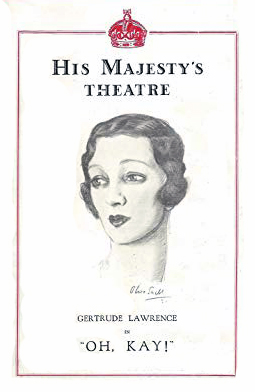
Musical
Original London
5) Oh, Kay! (Original London)
Joué durant 6 mois
Nb de représentations: 215 représentations
Première preview: Inconnu
Première: 21 September 1927
Dernière: 24 March 1928
Compositeur: George Gershwin •
Parolier: Ira Gershwin •
Libettiste: Guy Bolton • P.G. Wodehouse •
Metteur en scène:
Chorégraphe:
Avec: Gertrude Lawrence (Kay Denham), Harold French (Jimmy Winter), John Kirby (Shorty McGee), Claude Hulbert (Duke of Datchet), Beth & Betty Dodge (Phil & Dolly Ruxton), Eric Coxon (Larry Potter), April I larmon (Constance Appleton), Percy Parsons (Revenue Officer), Rita McLean (Molly Morse)
Commentaire: Gertrude Lawrence became the first English actress to originate a role on Broadway before playing it in London. The Broadway production opened in November 1926 and ran for 256 performances, with Gertrude Lawrence playing opposite Oscar Shaw and Victor Moore. It was the first of two Gershwin musicals specially written Gertie Lawrence. (The second, “Treasure Girl”, was a flop.) (plus)
Presse: Times found the plot “incomprehensible” and the music “commonplace,” but declared: “What might [Gertrude Lawrence] not do with really good material!”
Plus d'infos sur cette production:
Plus d'infos sur ce musical

Revue
Original
4) Co-Optimists (The) of 1926 (Original)
Joué durant 5 mois 3 semaines
Nb de représentations: 216 représentations
Première preview: 25 August 1926
Première: 25 August 1926
Dernière: 12 February 1927
Compositeur: *** Divers •
Parolier: *** Divers •
Libettiste: *** Revue •
Metteur en scène:
Chorégraphe:
Avec: Davy Burnaby, Austin Melford, Gilbert Childs, Stanley Holloway, Melville [J.] Gideon, Wolseley Charles. Mary Leigh, Doris Bentley, Marjorie Spiers, Sheila Rawle.
Commentaire:
Presse:
Plus d'infos sur cette production:
Plus d'infos sur ce musical
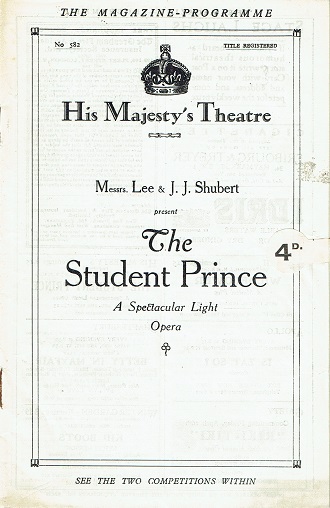
Opérette
Original London
3) Student Prince (The) (Original London)
Joué durant 2 mois 4 semaines
Nb de représentations: 97 représentations
Première preview: 03 February 1926
Première: 03 February 1926
Dernière: 03 May 1926
Compositeur: Sigmund Romberg •
Parolier: Dorothy Donnelly •
Libettiste: Dorothy Donnelly •
Metteur en scène: J.C. Huffman •
Chorégraphe:
Avec: Allan Prior (Karl Franz), Ilse Marvenga (Kathie), Herbert Waterous (Dr Engel), Oscar Figman (Lutz), Lucyenne Herval (Princess Margaret), John Coast (Capt. Tarnitz), Raymond Marlow (Detlef)
Commentaire:
Presse: Le Times a critiqué la pièce pour son manque d’humour et noté son américanisme.
Plus d'infos sur cette production:
Plus d'infos sur ce musical
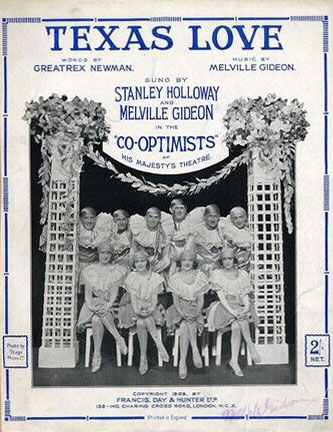
Revue
Original
2) Co-Optimists (The) of 1925 (Original)
Joué durant 5 mois 1 semaine
Nb de représentations: 200 représentations
Première preview: 26 August 1925
Première: 26 August 1925
Dernière: 30 January 1926
Compositeur: *** Divers •
Parolier: *** Divers •
Libettiste: *** Revue •
Metteur en scène:
Chorégraphe:
Avec: Davy Burnaby, Gilbert Childs, Austin Melford, Melville [J.] Gideon, Stanley Holloway, Wolseley Charles. Anita Elson, Doris Bentley, Betty Chester, Cicely James.
Commentaire:
Presse:
Plus d'infos sur cette production:
Plus d'infos sur ce musical
